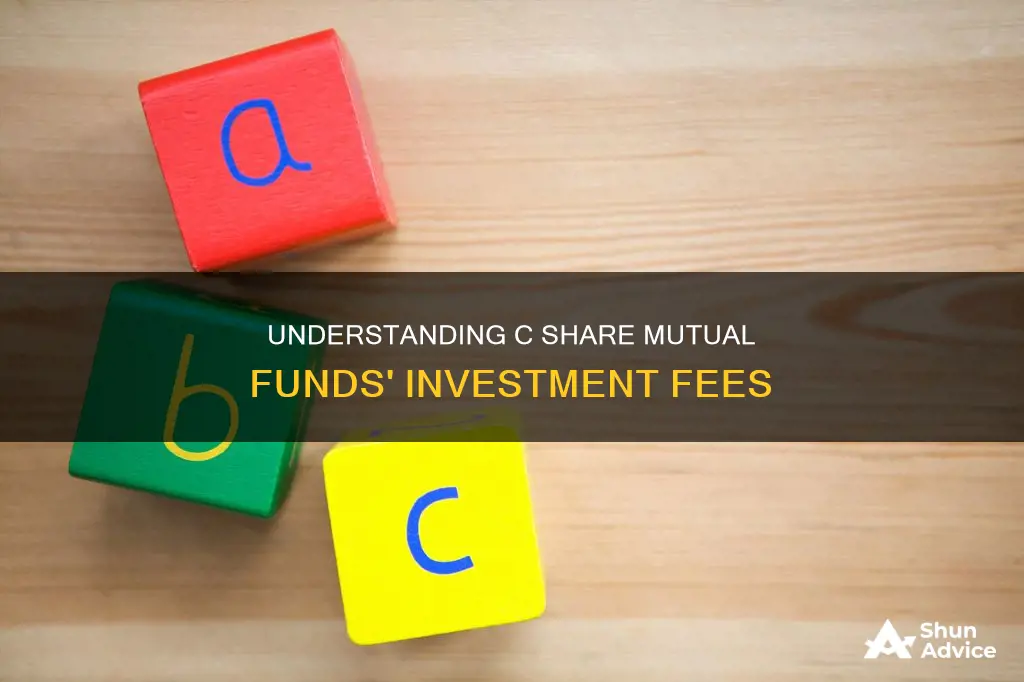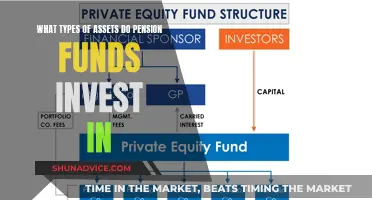
Mutual funds are divided into different classes, with the three main classes being Class A, Class B, and Class C shares. Each class has a different fee structure, with Class C shares being level-load, meaning there is no front-end load and typically no back-end load. Instead, investors who buy Class C shares pay an annual fee for the life of their investment. This annual fee is officially known as a 12b-1 fee, which covers fund marketing, distribution, and servicing. These fees are set at a fixed percentage and are charged annually. While Class C shares have no front-end fees, they often carry a small back-end load, known as a contingent deferred sales charge (CDSC), which is usually only around 1% and is waived after the investor has held the mutual fund for a year.
| Characteristics | Values |
|---|---|
| Type of fee | Annual fee |
| Who pays the fee | The investor |
| When is the fee paid | Every year for the life of their investment |
| What is the fee for | Marketing, distribution, and servicing |
| How much is the fee | A fixed percentage |
| Are there other fees | Management fee, 12b-1 fee |
| What is the management fee for | Paying fund managers and investment advisors |
| What is the 12b-1 fee for | Marketing and distribution of the fund and other shareholder services |
| How much are the management and 12b-1 fees | Management fee tends to be the same for all share classes, 12b-1 fee can differ from class to class |
| What is the maximum 12b-1 fee | 1% annually |
| What is included in the 12b-1 fee | Up to 0.75% for distribution and marketing expenses, up to 0.25% for service fees |
| Are there other types of mutual fund shares | Yes, Class A shares and Class B shares |
| What is the difference between the classes | Each class has a different fee structure |
| Are there other names for Class C shares | Level-load shares |
What You'll Learn

C-share level load
Class C shares are a type of level-load fund, which means they charge an annual fee instead of a front-end or back-end load. The level load includes annual charges for fund marketing, distribution, and servicing, set at a fixed percentage. These fees are officially known as 12b-1 fees and are capped at 1% annually. Distribution and marketing expenses can be up to 0.75%, while service fees max out at 0.25%. In essence, the 12b-1 fee is a commission paid by the investor to the mutual fund every year, rather than a transactional one.
Class C shares are popular among retail investors and are generally recommended for those with a short-term investment horizon of one to three years. This is because, unlike Class A shares, they do not have a front-end load, and the back-end load is typically waived after the shares have been held for one year. This means that the full amount of the initial investment can be put towards the purchase of shares, and investors can exit after a year without incurring additional fees. However, the annual fee is ongoing, and over time, it can eat into investors' returns. Therefore, Class C shares are less suitable for long-term investors.
In summary, C-share level load refers to the annual fees associated with Class C mutual fund shares. These fees cover marketing, distribution, and servicing expenses and are capped at 1% per year. Class C shares are attractive to short-term investors as they offer the advantage of no front-end load and a small, waivable back-end load. However, the ongoing nature of the annual fee can make Class C shares costly for long-term investors.
Equity Funds: Safe Investment or Risky Business?
You may want to see also

12b-1 fees
These fees are an annual charge, and are typically between 0.25% and 0.75% of a fund's net assets, though they can be as high as 1% for most mutual funds. The fees are paid by fund managers, who use client assets under management to pay service providers. The 12b-1 fee is used to compensate brokers and others who sell fund shares, as well as to pay for advertising, printing and mailing prospectuses to new investors, and sales literature.
The 12b-1 fee is included in the mutual fund's expense ratio, which is detailed in the fund's prospectus. The prospectus will also detail other fees and charges, such as sales charges and operational expenses.
The 12b-1 fee is controversial, as mutual funds have become much more popular since the 1970s, and the original motivation for the fee is no longer relevant. Critics argue that it is unnecessary for funds to charge investors for marketing to potential investors.
To avoid these fees, investors can look for mutual funds with low expense ratios, which are often index or passively managed funds. Additionally, investors can read the fund's prospectus, which will detail the shareholder fees, including the 12b-1 fee.
Target Date Funds: Charles Schwab Investment Strategies
You may want to see also

Annual fund operating expenses
The total annual fund operating expenses are required to be disclosed to investors in a fund's prospectus, which is a legal document that each mutual fund must file with the SEC. These expenses are expressed as a ratio known as the total expense ratio (TER), representing the fund's costs as a percentage of its total assets.
The following are some of the key categories of fund operating expense:
- Management fees: The cost of paying fund managers and investment advisors, which is typically the largest portion of a fund's operating expenses.
- 12b-1 fees: Fees capped at 1% that cover the cost of marketing, distribution, and selling the fund, as well as other shareholder services.
- Other expenses: These may include custodial, legal, accounting, transfer agent, and other administrative costs.
It is important to note that a fund's sales loads are not included in its annual operating expenses but are reported separately in the prospectus.
When considering investing in a mutual fund, it is crucial to understand the different types of fees and expenses associated with the fund. Even small differences in fees can significantly impact your investment returns over time.
A Guide to Investing in BDO Equity Funds
You may want to see also

Shareholder fees
Mutual fund fees can be broadly categorized into two types: Annual fund operating expenses and shareholder fees. Shareholder fees are sales commissions and other one-time costs incurred when buying or selling mutual fund shares.
- Sales loads: These are commissions paid when buying or selling mutual fund shares. A fee paid at the time of purchase is called a "front-end load," while a fee paid at the time of sale is known as a "back-end load." Front-end loads reduce the amount available to purchase fund shares. For example, a 5% front-end load on a $10,000 investment would result in a $500 sales load, leaving $9,500 to purchase fund shares.
- Redemption fee: This is charged by some funds if an investor sells their shares within a short period after purchasing them, which could range from a few days to over a year.
- Exchange fee: This is charged by some funds when shareholders transfer their shares to another fund offered by the same investment company.
- Account fee: This is a fee charged to maintain an investor's account, often imposed when the balance falls below a specified minimum investment amount.
- Purchase fee: This is a fee paid to the fund at the time of purchase, distinct from a front-end sales load, which is paid to the broker for selling the fund.
It is important to note that even if a mutual fund does not impose sales loads, it may still charge redemption, exchange, account, and purchase fees.
Nippon India Multi-Asset Fund: Smart Investment Strategies
You may want to see also

No-load funds
When considering a no-load fund, it is important to read the fund's prospectus to understand all the associated fees and potential restrictions on share redemption.
Manulife Financial: A Regulated Mutual Fund Company?
You may want to see also
Frequently asked questions
C share mutual funds are a class of mutual fund shares that have a level load, which means there is no front-end load and typically no back-end load. Instead, investors pay an annual fee for the life of their investment. C shares are best suited for investors with a short investment time horizon of one to three years.
C share mutual funds have higher expense ratios than A-shares. They also have a small exit fee, typically around 1%, which is usually waived after one year. C shares also carry the highest ongoing expenses of the three main share classes (A, B, and C). These include management fees, 12b-1 fees, and other administrative costs.
C share mutual funds are generally suitable for investors with a short-term investment horizon, typically more than one year and less than three years. They are also popular with retail investors. If you are planning to invest for the long term and prefer lower costs, C shares may not be the best option.







